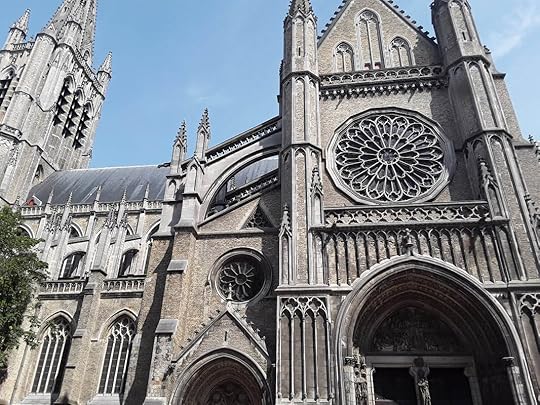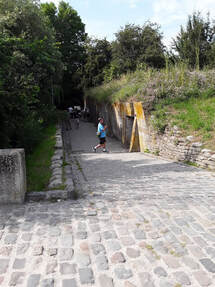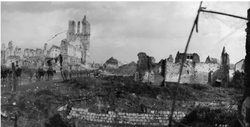Ypres: The Belgian Town with Many Names and a Lot of History
In 2019, my husband and I were able to tour the World War I battlefields in Belgium and France. We visited many cities and towns, but my favorite was Ypres, a town with many names and a lot of history.
Ypres is the third largest city in the Flanders, right behind Ghent and Bruges. Its official name is its Flemish one, Leper, but it is most commonly called by its French name, Ypres. It most likely got its name from its proximity to the Yperlee, or Leperlee, River. During World War I, British soldiers often renamed the places whose names felt strange to their tongues. The town of Bailleul became Baloo, Étaples became Eat Apples, Foncquevillers.was called Funky Villages, and Ypres became Wipers..
Ypres is an ancient town. The Romans raided it in the first century BC, mentioning it in their records by location. The first written record of the name is from 1066.
During the Middle Ages, Ypres became a major cloth-weaving city. It was such an important trading partner, its linen so valuable to the English that it is mentioned in the Canterbury Tales. England's Edward III offered economic incentives and protection to Flemish weavers, who migrated to the island nation in large numbers.Ypres cloth, both linen and woolen, was available as far away as the city of Novgorod, in Kievan Rus. Its population grew, possibly to as large as 80,000. It was during this peak of power that the famous Cloth Hall was built. Erected between 1260 and 1304, it was a jewel of gothic architecture and a testament to the riches that were pouring into Ypres. Behind it sits Saint Martin's Cathedral, which was built in 1221. Above: The Cloth Guild Hall. Below: the Cathedral Author's photos.
Above: The Cloth Guild Hall. Below: the Cathedral Author's photos. 
 A section of the old town walls Ypres had long been fortified to keep out invaders. Parts of the early ramparts, dating from 1385, still survive near the Rijselpoort (Lille Gate). Over time, the earthworks were replaced by sturdier masonry and earth structures and a partial moat. Ypres was further fortified in the 17th and 18th centuries. These fortifications did not always protect the city, and the devastation of war and siege. The city has been under French, Spanish, and Habsburg control. Its population dwindled to about 5,000.
A section of the old town walls Ypres had long been fortified to keep out invaders. Parts of the early ramparts, dating from 1385, still survive near the Rijselpoort (Lille Gate). Over time, the earthworks were replaced by sturdier masonry and earth structures and a partial moat. Ypres was further fortified in the 17th and 18th centuries. These fortifications did not always protect the city, and the devastation of war and siege. The city has been under French, Spanish, and Habsburg control. Its population dwindled to about 5,000.
By the turn of the 20th century, the town looked old and worn. An extensive rebuilding program restored the Cloth Hall and Cathedral to their former glories. The town's restored beauty was not to last, however. Because it stood in the path of Germany's Schlieffen Plan, Ypres occupied a strategic position during the First World War. Belgium's neutrality was guaranteed by Britain, bringing the British Empire into the war and many hundreds of thousands of British soldiers into the Ypres area. The German army bombarded the city until it was reduced to ruins. The last inhabitants abandoned the city in 1915. By 1917 not a single house or tree remained standing. Canadian troops passing the ruins of the Cloth Hall. Image from Library and Archives Canada After the war the town was extensively rebuilt using money paid by Germany in reparations. The main square, including the Cloth Hall, town hall, and Cathedral were rebuilt based on the renovation plans from before the war. Today, Ypres is home to about 34,900 inhabitants. The restored Cloth Hall now houses In Flanders Fields Museum, which is dedicated to Ypres's role in the First World War and named for the poem by Canadian John McCrae. St. George's Chapel, which faces the Cathedral, remains a center of British culture in the town and a pilgrimage site for British Citizens who lost loved ones during WWI. The Menin Gate, in the city's east walls, holds the names of soldiers of the British Commonwealth who fell near Ypres before August 16, 1917 but who have no known grave. Soldiers who died later are commemorated elsewhere. As graves are identified, the names of those buried in them are removed from the Gate.
Canadian troops passing the ruins of the Cloth Hall. Image from Library and Archives Canada After the war the town was extensively rebuilt using money paid by Germany in reparations. The main square, including the Cloth Hall, town hall, and Cathedral were rebuilt based on the renovation plans from before the war. Today, Ypres is home to about 34,900 inhabitants. The restored Cloth Hall now houses In Flanders Fields Museum, which is dedicated to Ypres's role in the First World War and named for the poem by Canadian John McCrae. St. George's Chapel, which faces the Cathedral, remains a center of British culture in the town and a pilgrimage site for British Citizens who lost loved ones during WWI. The Menin Gate, in the city's east walls, holds the names of soldiers of the British Commonwealth who fell near Ypres before August 16, 1917 but who have no known grave. Soldiers who died later are commemorated elsewhere. As graves are identified, the names of those buried in them are removed from the Gate.
Every evening at eight o'clock, traffic around the imposing arches of the Menin Gate Memorial stops while buglers sound the "Last Post." During the Second World War Germans who occupied the city prohibited the ceremony, so it was hosted at Brookwood Military Cemetery in England. The ceremony resumed on September 6, 1944 the day the city was liberated, even though there was still heavy fighting in other parts of the town. If you were to walk through Ypres today without knowing its history, you might think what a cute and quaint medieval town it is. But the gothic buildings are all new, rebuilt after the horror of war had reduced them to rubble. And although the buildings are rebuilt, the memory of trauma remains. Ypres is not a town that will ever forget the horror it went through a hundred years ago. Although she fell in love with Ypres, the scenes in Jennifer Bohnhoff's WWI novel A Blaze of Poppies do not take place in this area, but farther to the south, in France.
Although she fell in love with Ypres, the scenes in Jennifer Bohnhoff's WWI novel A Blaze of Poppies do not take place in this area, but farther to the south, in France.
One of the reasons she so loved this area is that her guide, Iain McHenry, breathed so much life into the area. An historian and the author of Subterranean Sappers: A History of 177 Tunnelling Company RE from 1915 to 1919, the definitive book on WWI sappers in the Ypres Salient, he comes highly recommended for the breadth of his knowledge of the area and its battles.
Ypres is the third largest city in the Flanders, right behind Ghent and Bruges. Its official name is its Flemish one, Leper, but it is most commonly called by its French name, Ypres. It most likely got its name from its proximity to the Yperlee, or Leperlee, River. During World War I, British soldiers often renamed the places whose names felt strange to their tongues. The town of Bailleul became Baloo, Étaples became Eat Apples, Foncquevillers.was called Funky Villages, and Ypres became Wipers..
Ypres is an ancient town. The Romans raided it in the first century BC, mentioning it in their records by location. The first written record of the name is from 1066.
During the Middle Ages, Ypres became a major cloth-weaving city. It was such an important trading partner, its linen so valuable to the English that it is mentioned in the Canterbury Tales. England's Edward III offered economic incentives and protection to Flemish weavers, who migrated to the island nation in large numbers.Ypres cloth, both linen and woolen, was available as far away as the city of Novgorod, in Kievan Rus. Its population grew, possibly to as large as 80,000. It was during this peak of power that the famous Cloth Hall was built. Erected between 1260 and 1304, it was a jewel of gothic architecture and a testament to the riches that were pouring into Ypres. Behind it sits Saint Martin's Cathedral, which was built in 1221.
 Above: The Cloth Guild Hall. Below: the Cathedral Author's photos.
Above: The Cloth Guild Hall. Below: the Cathedral Author's photos. 
 A section of the old town walls Ypres had long been fortified to keep out invaders. Parts of the early ramparts, dating from 1385, still survive near the Rijselpoort (Lille Gate). Over time, the earthworks were replaced by sturdier masonry and earth structures and a partial moat. Ypres was further fortified in the 17th and 18th centuries. These fortifications did not always protect the city, and the devastation of war and siege. The city has been under French, Spanish, and Habsburg control. Its population dwindled to about 5,000.
A section of the old town walls Ypres had long been fortified to keep out invaders. Parts of the early ramparts, dating from 1385, still survive near the Rijselpoort (Lille Gate). Over time, the earthworks were replaced by sturdier masonry and earth structures and a partial moat. Ypres was further fortified in the 17th and 18th centuries. These fortifications did not always protect the city, and the devastation of war and siege. The city has been under French, Spanish, and Habsburg control. Its population dwindled to about 5,000. By the turn of the 20th century, the town looked old and worn. An extensive rebuilding program restored the Cloth Hall and Cathedral to their former glories. The town's restored beauty was not to last, however. Because it stood in the path of Germany's Schlieffen Plan, Ypres occupied a strategic position during the First World War. Belgium's neutrality was guaranteed by Britain, bringing the British Empire into the war and many hundreds of thousands of British soldiers into the Ypres area. The German army bombarded the city until it was reduced to ruins. The last inhabitants abandoned the city in 1915. By 1917 not a single house or tree remained standing.
 Canadian troops passing the ruins of the Cloth Hall. Image from Library and Archives Canada After the war the town was extensively rebuilt using money paid by Germany in reparations. The main square, including the Cloth Hall, town hall, and Cathedral were rebuilt based on the renovation plans from before the war. Today, Ypres is home to about 34,900 inhabitants. The restored Cloth Hall now houses In Flanders Fields Museum, which is dedicated to Ypres's role in the First World War and named for the poem by Canadian John McCrae. St. George's Chapel, which faces the Cathedral, remains a center of British culture in the town and a pilgrimage site for British Citizens who lost loved ones during WWI. The Menin Gate, in the city's east walls, holds the names of soldiers of the British Commonwealth who fell near Ypres before August 16, 1917 but who have no known grave. Soldiers who died later are commemorated elsewhere. As graves are identified, the names of those buried in them are removed from the Gate.
Canadian troops passing the ruins of the Cloth Hall. Image from Library and Archives Canada After the war the town was extensively rebuilt using money paid by Germany in reparations. The main square, including the Cloth Hall, town hall, and Cathedral were rebuilt based on the renovation plans from before the war. Today, Ypres is home to about 34,900 inhabitants. The restored Cloth Hall now houses In Flanders Fields Museum, which is dedicated to Ypres's role in the First World War and named for the poem by Canadian John McCrae. St. George's Chapel, which faces the Cathedral, remains a center of British culture in the town and a pilgrimage site for British Citizens who lost loved ones during WWI. The Menin Gate, in the city's east walls, holds the names of soldiers of the British Commonwealth who fell near Ypres before August 16, 1917 but who have no known grave. Soldiers who died later are commemorated elsewhere. As graves are identified, the names of those buried in them are removed from the Gate.Every evening at eight o'clock, traffic around the imposing arches of the Menin Gate Memorial stops while buglers sound the "Last Post." During the Second World War Germans who occupied the city prohibited the ceremony, so it was hosted at Brookwood Military Cemetery in England. The ceremony resumed on September 6, 1944 the day the city was liberated, even though there was still heavy fighting in other parts of the town. If you were to walk through Ypres today without knowing its history, you might think what a cute and quaint medieval town it is. But the gothic buildings are all new, rebuilt after the horror of war had reduced them to rubble. And although the buildings are rebuilt, the memory of trauma remains. Ypres is not a town that will ever forget the horror it went through a hundred years ago.
 Although she fell in love with Ypres, the scenes in Jennifer Bohnhoff's WWI novel A Blaze of Poppies do not take place in this area, but farther to the south, in France.
Although she fell in love with Ypres, the scenes in Jennifer Bohnhoff's WWI novel A Blaze of Poppies do not take place in this area, but farther to the south, in France.One of the reasons she so loved this area is that her guide, Iain McHenry, breathed so much life into the area. An historian and the author of Subterranean Sappers: A History of 177 Tunnelling Company RE from 1915 to 1919, the definitive book on WWI sappers in the Ypres Salient, he comes highly recommended for the breadth of his knowledge of the area and its battles.
Published on October 19, 2023 23:00
No comments have been added yet.



